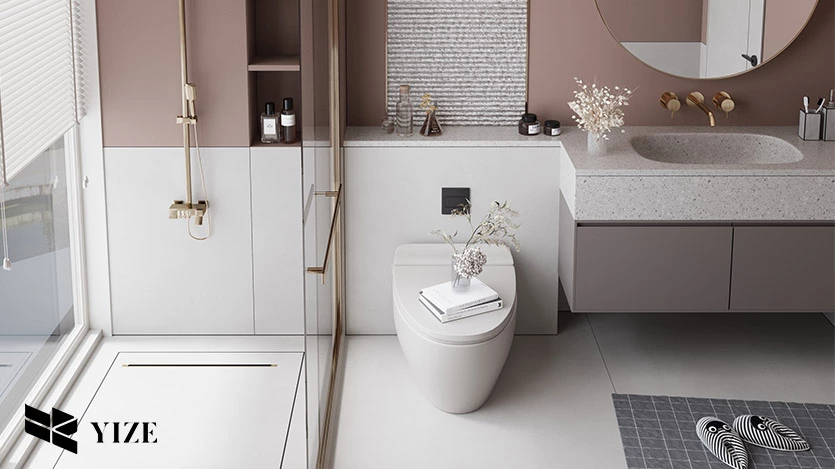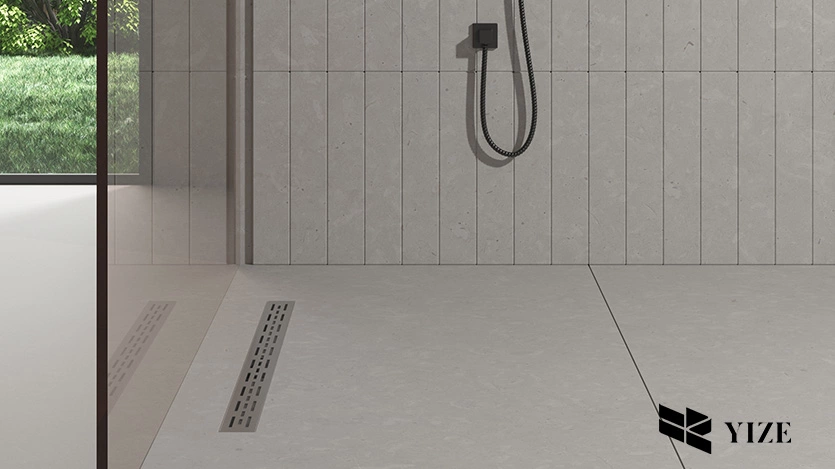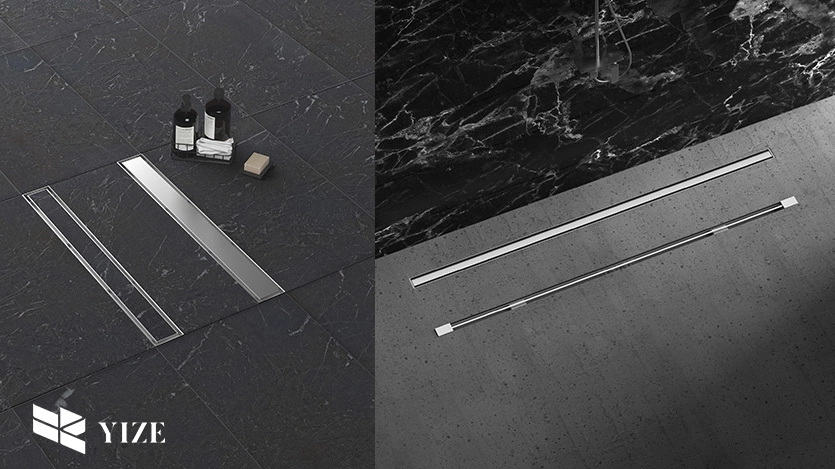
I. Introduction
When planning a bathroom, the most common things that come to mind are tiles, lighting and fixtures. But there’s one important detail often overlooked: the drainage system. A trench drain bathroom is a vital part of the bathroom and when its design is pleasant it enhances the beauty and utility of the bathroom. Bathrooms have evolved into more modern and minimalistic places. Therefore, the drainage solutions themselves should not be eye-catching and visually bulky.
In this article, you will learn all about the five most popular types of bathroom trench drains that would look great in modern, minimalist bathroom designs. Each style has its own possibilities, so when you decide to make or redesign a bathroom in your house, you will choose the right option for you.
II. Linear Drain Style
Line drains are among the most commonly used trench drain types for contemporary bathrooms. These drains are a rectangulary channel that covers the length of the shower or bathroom floor. Water converges on a central point, the drain, and this makes the drain free and quick. This kind of drain is commonly disguised under a smooth lid or a mat, and the materials used in the bathroom flooring can be used to make the cover.
Key Features of Linear Drains:
- Sleek Appearance: The silhouette of your Kaldewei bathroom bathtub is slim and straight-line, imparting a modern appearance.
- Flexible Placement: The linear drains can be installed along the wall, in the middle of the shower floor, or at the shower base and entryway.
- Efficient Drainage: Their design lets water easily enter the drain from several angles and not stand on the surface.
Because of their layout, the linear drains are appropriate for modern bathroom designs where every centimetre counts. They merge well with the floor and come in a wide variety of such as steel,and brushed nickel, to name but a few which enable one to match the set décor of the bathroom.
III. Slot Drain Style

Slot drains are another example of a minimal buttress to bathroom drainage. While a linear drain has a wide channel with U-shape or rectangular cross-section, slot drains are characterised by a slit-like channel with a rectangular cross-section, usually just a few millimeters wide and running from floor to floor. These drains may be placed at any part of the bathroom, the edges mostly along the walls or within the middle part of the bathroom.
Key Features of Slot Drains:
- Discrete Design: The slim form provides a concealed drainage channel that suits floor tiles and all types of natural stone flooring.
- Flush with Floor: Slot drains are normally recessed, which gives them the level of the floor in most cases without any grating or raised edges.
- Easily Concealed: The thin slot is far more discreet than the generally visible drains and provides a sleek and classy appearance.
Slot drains are ideal for current architectural designs where a smooth floor look is significant to establish continuous and integrated floor drainage without obstructive or bulky drain gratings in the floor of the bathroom. These drains are perfect for any person who is looking for minimum visibility of the drains while ensuring maximum performance.
IV. Hidden Drain Style
The hidden drain is another one that could be described very literally—it is the drain that is absolutely invisible, or, in other words, that is perfectly invisible in the landscape. Usually, the drain is fixed in a hidden manner, and the water is channeled to the hidden drains fitted beneath the floor tiles. This design is most appropriate for a modern-looking bathroom where the pipework is hidden, and there is no sign of drainage.
Key Features of Hidden Drains:
- Invisible Drainage: There’s no pipe visible from the drain, and therefore, it is suitable for minimalist designs as it is completely tiled.
- Continuous Floor Surface: Since none of them have len acts, the floor surface they provide has no interruptions, giving it an interphase appearance.
- Customizable Grates: Although the drain requires to be installed in a concealed manner the full or partial cover can just be designed to blend or complement the bathroom decor.
Especially if you wish to minimise drain covers’ presence and make the floor the centre of attention, hidden drains are a perfect choice. This style is highly preferred in luxury bathroom remodelling works because of its simplified and discreet appearance.
V. Tile-In Drain Style

Tile-in drains are halfway between conventional floor drains and Linear trench drains. These drains are to be installed right into the floor tiles so they can blend well with the rest of the floor that you may already have. The drain cover provided has a special design to let you install tiles on it, therefore,it’s possible to use the same tile as the floor of the bathroom; therefore it would blend with the bathroom very well.
Key Features of Tile-In Drains:
- Customizable Look: If you want an even neater look, then the drain cover can be made to blend with the kind of tiles that have been used.
- Minimized Visibility: Unlike the tile-over structure that only covers the drain slightly and exposes much of the plumbing, the tile-in structure is neater and polished.
- Flexible Application: This style is great for bathrooms of all sizes and is suitable with almost any type of tile including ceramic or stone.
Tile-in drains are slightly better for those who aim for a seamless, fully integrated bathroom design. It blends easily with the floor, thus providing an opportunity for an unbroken look in cases where the bathroom is done in a modern or minimalist style.
VI. Channel Drain Style
Channel drains are another type of drain that could be installed for people who are looking for something both modern and effective. Pond drain style refers to a long and rectangular drain trench built to collect water from an area that surrounds the pond. There is normally an iron or plastic cover over the channel drains, but generally, the structure of channel drains is quite discreet.
Key Features of Channel Drains:
- Wide Coverage: Favourable features of channel drains include a large drainage surface, which improves the water flow and is less likely to block.
- Low Profile: But despite this property, these channel drains are not aggressive in the looks department: they are designed to be unobtrusive yet still remain easily noticeable.
- Durable Materials: Coming in a variety of options, such as stainless steel and brass, these drains are robust while incorporating style and elegance.
Perfect for bathrooms where water has to be drained away across a wide area, channel then provides the correct look and the right performance. This drain type is appropriate for large bathrooms or areas where much water flow is required and has to be channelled in a rather large area.
VII. Benefits of Bathroom Trench Drains

The selection of the bathroom trench drain is, therefore, a critical influence on the efficiency as well as aesthetic appeal of a bathroom area. Here are some key benefits of installing a trench drain system in your bathroom:
- Space Efficiency: Trench drains take advantage of the long, narrow space on the floor, which has been very coveted in recent bathroom designs.
- Low Maintenance: The trench drains are easy to maintain as they have few pieces that can be blocked or corroded than the shower drains.
- Improved Drainage: This is because the typical installation of trench drains means water actually moves more freely and isn’t stagnant or a possible cause for a flood.
- Sleek, Modern Look: Trench drains can be used in a modern/ minimalist look concept since they do not extend into the room, and the bathroom drainage system will not interfere with the final look of the entire space.
VIII. Conclusion
This article explains that it is possible to select the most appropriate trench drain to support your bathroom in being both beautiful and functional. Both slot drains and tile-in drains are designed for today’s futuristic bathrooms, where aesthetics play an important role alongside functionality. The right drainage system installed in the bathroom can take that room from being a place you merely tolerate into a space that not only comforts you when you bathe, shower, or do your business but also who you turn to for aesthetic pleasure and durability.
Frequently Asked Questions (FAQs)
1. What is the difference between a linear drain and a slot drain?
A linear drain is long and slim and is typically installed along the edge of the shower; a slot drain is shallow with a thin slit which makes it much less noticeable. While designing, they both give proper water-shedding methods but the latter are discreet compared to slot drains.
2. Can a bathroom trench drain be installed in an existing bathroom?
It is definitely possible to install trench drains during a remodel, but some changes to the floor may be required. It is recommended to consult an experienced installer who will be able to solve drainage issues and fit it in the overall design of a bathroom.
